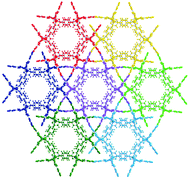Dipyridyl β-diketonate complexes and their use as metalloligands in the formation of mixed-metal coordination networks†
Abstract
The iron(III) and aluminium(III) complexes of 1,3-di(4-pyridyl)propane-1,3-dionato (dppd) and 1,3-di(3-pyridyl)propane-1,3-dionato (dmppd), [Fe(dppd)3] 1, [Fe(dmppd)3] 2, [Al(dppd)3] 3 and [Al(dmppd)3] 4 have been prepared. These complexes adopt molecular structures in which the metal centres contain distorted octahedral geometries. In contrast, the copper(II) and zinc(II) complexes [Cu(dppd)2] 5 and [Zn(dmppd)2] 6 both form polymeric structures in which coordination of the pyridyl groups into the axial positions of neighbouring metal centres links discrete square-planar complexes into two-dimensional networks. The europium complex [Eu(dmppd)2(H2O)4]Cl·2EtOH·0.5H2O 7 forms a structure containing discrete cations that are linked into sheets through hydrogen bonds, whereas the lanthanum complex [La(dmppd)3(H2O)]·2H2O 8 adopts a one-dimensional network structure, connected into sheets by hydrogen bonds. The iron complexes 1 and 2 act as metalloligands in reactions with silver(I) salts, with the nature of the product depending on the counter-ions present. Thus, the reaction between 1 and AgBF4 gave [AgFe(dppd)3]BF4·DMSO 9, in which the silver centres link the metalloligands into discrete nanotubes, whereas reactions with AgPF6 and AgSbF6 gave [AgFe(dppd)3]PF6·3.28DMSO 10 and [AgFe(dppd)3]SbF6·1.25DMSO 11, in which the metalloligands are linked into sheets. In all three cases, only four of the six pyridyl groups present on the metalloligands are coordinated. The reaction between 2 and AgNO3 gave [Ag2Fe(dmppd)3(ONO2)]NO3·MeCN·CH2Cl212. Compound 12 adopts a layer structure in which all pyridyl groups are coordinated to silver centres and, in addition, a nitrate ion bridges between two silver centres. A similar structure is adopted by [Ag2Fe(dmppd)3(O2CCF3)]CF3CO2·2MeCN·0.25CH2Cl213, with a bridging trifluoroacetate ion playing the same role as the nitrate ion in 12.

- This article is part of the themed collection: Coordination chemistry in the solid state

 Please wait while we load your content...
Please wait while we load your content...